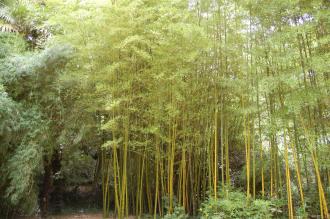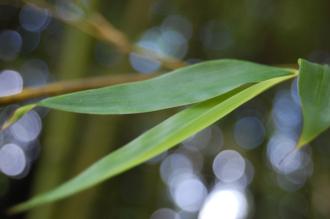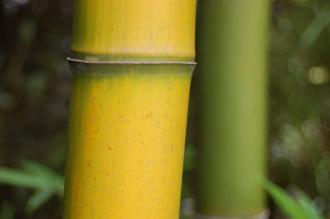
Phyllostachys pubescens (28/07/2014, Botanique National de Brest, France)
Position: Sun to dappled shade
Flowering Period: N/A
Soil: Moist, well drained
Eventual Height: 20m
Eventual Spread: 2.5m
Hardiness: 7a, 7b, 8a, 8b, 9a, 9b, 10a, 10b
Family: Poaceae
Phyllostachys pubescens is a spreading, evergreen, running bamboo. Its mid green leaves appear in groups of 2 or 3, are linear with entire margins and are up to 12cm long and 15mm broad. Its yellow culms are very straight, have a hard texture and are up to 12cm in diameter. Its culm sheaths are brown in color. This plant spreads by underground rhizomes and can be very invasive.

Phyllostachys pubescens Leaf (28/07/2014, Botanique National de Brest, France)
Phyllostachys pubescens, commonly known as Moso Bamboo, is native to China and possibly Taiwan. It is the fastest growing plant in the world. In its native habitat it grows in monotypic stands of bamboo forest. Its new shoots are edible and commonly eaten in China and Japan.
The etymological root of the binomial name Phyllostachys is derived from the Greek phyllon meaning ‘leaf’ and stachys meaning ‘spike’. Pubescens is derived from the Latin pubes meaning ‘hair’ and the epithet -escens meaning ‘-ish’, in reference to its downy shoots.
The landscape architect may find Phyllostachys pubescens useful as a useful as a large screening plant that is low maintenance. It may be planted to stabilise soil. Caution must be exercised when specifying this plant due to its potentially invasive nature. A root barrier may be used to contain its spread.
Ecologically, Phyllostachys pubescens is of little wildlife value in the UK.

Phyllostachys pubescens Stem (28/07/2014, Botanique National de Brest, France)
Phyllostachys pubescens prefers moist, humus rich, well-drained soils. It tolerates most pH of soil. It requires a lot of moisture during its shooting time from March to May.
Phyllostachys pubescens requires little to no maintenance. A root barrier may be installed at the time of planting to restrict the spread of this plant. The plant may be thinned out of required and spent canes may be cut back to the ground level.

